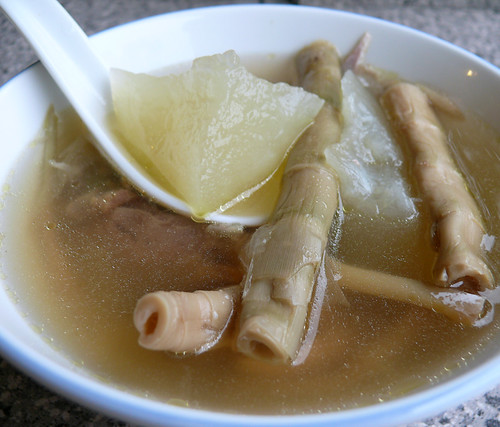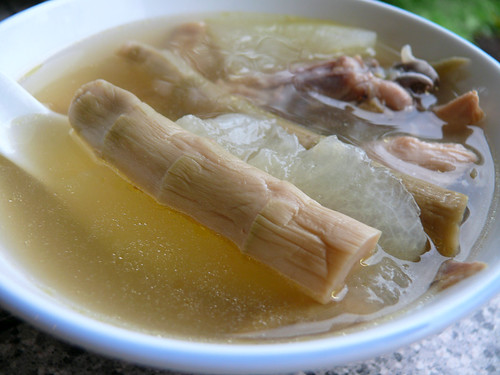
Shanghainese winter melon soup
Some of the most popular Chinese soups I can think of are lotus root soup, winter melon soup, white carrot soup and watercress soup. These soups, which are simmered for at least 2 hours, are served in most restaurants. Every respectable Chinese housewife should be able to not just cook these soups, but cook them them well.
Chinese soups are easy to cook. Everything goes into the pot to be simmered for at least two hours or about four hours if it's double-boiled (soups are double-boiled in a ceramic tureen or crock which sits in a pot of water so the heat is indirect and very gentle, just like a bain marie). The Cantonese believe that 'long-boiled' soups invigorate and rejuvenate the body and people who have recovered from illness are made to drink lots of double-boiled soups.
Winter melon soup is one of my favorite soups, especially if the melon is the pandan-flavored winter melon. The whole house can be scented by the fragrance of the melon as the soup cooks. The most common way to cook winter melon soup is to simmer the soup with red dates, salted turnip and meat or bones, and the Cantonese will add a small handful of dried oysters although if a less robust but more refreshing soup is preferred, the dried oysters can be omitted. The Shanghainese winter melon soup is just as simple, but instead of dried turnip, salted young bamboo tips called "beeji" in Shanghainese and "bian jian sun" in Mandarin are used and Chinese ham replaces dried oysters. I've not found beeji in KK but they are found in Asian grocers in Australia and they keep well in the fridge. My daughter loves beeji like a dog loves bones. She's a true Shanghainese; they love bamboo. Beeji is crunchy-tender and fun to eat. It almost takes the limelight from the winter melon. I dig for the beeji in the pot more than I do the winter melon.
If you want a lighter, refreshing soup (Chinese soups are supposed to be such, to wash and clean the palate for the many varied dishes in a typical Chinese meal), a free-range chicken is best. I found a place to get REAL kampung chickens today (no, Yi, I didn't touch our pet chickens), and my soup turned out better than any I've made in a long time. I doubt that the kampung chickens sold in our wet markets are the real thing. They may be true kampung breed, but certainly not kampung-reared. Kampung-reared chickens are free to roam and feed on whatever they find while farmed kampung chickens are caged and feed on processed chicken feed. True kampung chickens have rather dirty-looking skin with lots of baby feathers still in the skin while farmed kampung chickens have smooth bald skin. True kampung chickens are also very skinny, weighing about 1.2 kg live. The truth will be revealed in the soup. Once you've tasted the real thing, you'll never go back to farmed chickens for your soups.

Some of the most popular Chinese soups I can think of are lotus root soup, winter melon soup, white carrot soup and watercress soup. These soups, which are simmered for at least 2 hours, are served in most restaurants. Every respectable Chinese housewife should be able to not just cook these soups, but cook them them well.
Chinese soups are easy to cook. Everything goes into the pot to be simmered for at least two hours or about four hours if it's double-boiled (soups are double-boiled in a ceramic tureen or crock which sits in a pot of water so the heat is indirect and very gentle, just like a bain marie). The Cantonese believe that 'long-boiled' soups invigorate and rejuvenate the body and people who have recovered from illness are made to drink lots of double-boiled soups.
Winter melon soup is one of my favorite soups, especially if the melon is the pandan-flavored winter melon. The whole house can be scented by the fragrance of the melon as the soup cooks. The most common way to cook winter melon soup is to simmer the soup with red dates, salted turnip and meat or bones, and the Cantonese will add a small handful of dried oysters although if a less robust but more refreshing soup is preferred, the dried oysters can be omitted. The Shanghainese winter melon soup is just as simple, but instead of dried turnip, salted young bamboo tips called "beeji" in Shanghainese and "bian jian sun" in Mandarin are used and Chinese ham replaces dried oysters. I've not found beeji in KK but they are found in Asian grocers in Australia and they keep well in the fridge. My daughter loves beeji like a dog loves bones. She's a true Shanghainese; they love bamboo. Beeji is crunchy-tender and fun to eat. It almost takes the limelight from the winter melon. I dig for the beeji in the pot more than I do the winter melon.
If you want a lighter, refreshing soup (Chinese soups are supposed to be such, to wash and clean the palate for the many varied dishes in a typical Chinese meal), a free-range chicken is best. I found a place to get REAL kampung chickens today (no, Yi, I didn't touch our pet chickens), and my soup turned out better than any I've made in a long time. I doubt that the kampung chickens sold in our wet markets are the real thing. They may be true kampung breed, but certainly not kampung-reared. Kampung-reared chickens are free to roam and feed on whatever they find while farmed kampung chickens are caged and feed on processed chicken feed. True kampung chickens have rather dirty-looking skin with lots of baby feathers still in the skin while farmed kampung chickens have smooth bald skin. True kampung chickens are also very skinny, weighing about 1.2 kg live. The truth will be revealed in the soup. Once you've tasted the real thing, you'll never go back to farmed chickens for your soups.


Shanghainese Winter Melon Soup
1 kg pork bones & meat or 1 x 1 kg kampung/village chicken, skinned
500 g piece of fragrant winter melon
100 g salted young bamboo tips, washed and soaked 10 minutes, repeat
a handful of red dates, washed
1 small piece (half a fist) of Chinese ham
Prep: The skin of the winter melon can be left on for extra fragrance but the Shanghainese don't seem to do that. Cut the melon into small chunks of about 4 cm squares. Trim off the hard end of the bamboo stem, if any. If using pork bones & meat, blanch them with boiling water.
1. Put the meat/bones into a pot, add water to cover with a clearance of about 5 cm. Add the ham, bamboo and red dates too and when the water boils, lower the heat until the soup simmers gently, covered.
2. After 1 1/2 hours, bring the soup to a rolling boil, add the winter melon and when the soup boils again, lower the heat and let the soup simmer gently for about 20 minutes, covered. Switch off heat and leave the pot covered.
3. Just before serving, re-heat the soup. Depending on how you like the soup and how much water has evaporated, you can add some water if necessary, but not too much or the taste will be diluted. There's no need to add salt as the bamboo and ham are salty.

10 comments:
This soup look yummy, remind me long time I did not cook this soup, must cook it soon..
hi terry :)
thank you so much for this recipe.
i am an ardent reader of your blog and have been following you since 2007. i think your blog is very informative and delicious to read. i am also adding your blog to my fav. link at my blog. i hope you don't mind. thank you for all the recipes and good stories you shared.
God bless :)
You mean I can get Beeji here in Asian grocery? Are they canned or packed?? I think for chic, the best I could get here are 'Old hen'.
make sure you don't touch the chicks!
my friend amanda has a pair of pet chickens too...she says they are serama chickens, and she's shown me pics - very cute, all white. they're like dogs - they come to her when they're called, they perch on her shoulder and they even jump into her arms to get her to hug them!!! it's amazing; i think she should be on 'ripley's believe it or not'. she said our chickens wont do the same because your imperial scholar chases them around.
Terri dear
I could not resist laughing when i read what Yi said and the double meaning:
Your imperial scholar chases after the "chicks". Hehe, no wonder Wey is distracted from studies :)
I think when all your kids are back home, you must have lots of moments not knowing whether to laugh or cry with their rascal antics :P Your family members definitely have an amazing sense of humour AND that is an AWESOME gift from our good Lord.
Much love :)
Hi Terri. I did not realise how much I miss soup til we moved out of the country. It is such a Godsend on cold winter nights!
I have not managed to find any kampung chicken - breed, reared or otherwise.. - so have to make do with regular farm-reared chicken. The taste of the soup comes out ok, but the meat is ugh.. mushy and tasteless!
Is salted turnip 'dai tao choy' (big head vegetable)?
wow i have never see this beeji thingy before. doubt can get in kuching. but i can almost smell the soup from the picture.
sonia: yes, esp if u've eaten too much durians. this is a cooling soup.
pauline: wow, since 2007? thank u:))
pp: they are in plastic packets like in the pic. try it!
yi:er..i don't want chickens on my shoulders, just in my soup. but there's a surprise for you when u come back--our yard will be filled with chicks bc one of the chicken is sitting on her 17 eggs! 17! if the other hen knew what to do, we'd have 33 chicks.we can start a chicken farm. we might even grow rich, what d u think?
mp: hi, sorry i've been slow with my mail. wey is hoarding the computer ALL the time. he's staying home after his exams bc i didn't let him sit for UEC. yes, when all 3 are together, all hell breaks loose. it's a fun time end of the year. i am so looking forward to the whole fam togehter again!
kat: yes, salted turnip is dai toe choy to me, n it's added to soups. interesting blog u hav there kat!
nee: remember to get linda or roger to get u some from the asian grocers. make sure u make greg lots of soup since he's burning his brain cells on his phD
Terry, I make winter melon soup with the addition of some red dates, shitake mushrooms & ginger. I've never heard of Chinese ham though I've cooked Asian food for decades. Does it taste like Western ham at all as I intensely dislike the taste? Or does it have a flavour more similar to Chinese pork sausage which I like? The salted bamboo sounds good! I'll have to look for some next time I shop.
I'm just recovering from a long nasty bout of penumonia & have been really craving Asian food & whe I saw winter melon in the produce, I knew I had to make some.
Thank you for posting such a useful, impressive and a wicked article./Wow.. looking good!!!!
Bain Marie for Sale Melbourne
Post a Comment